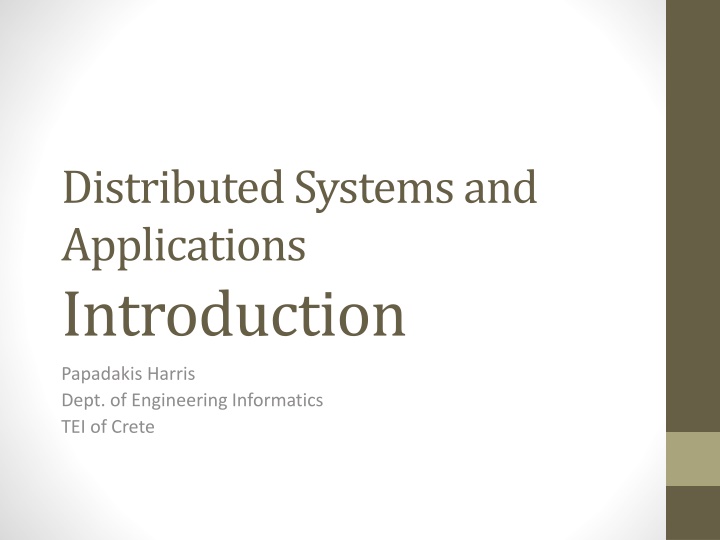
Introduction to Distributed Systems and Applications
Explore the world of distributed systems, parallel processing, and middleware in this comprehensive guide. Learn about the definition, examples, and evolution of distributed systems, as well as the role of middleware in creating a unified user experience. Discover the impact of powerful microprocessors and high-speed data networks in enabling the emergence of distributed systems. Dive into the concept of parallel processing and its role in improving processing speed without solely relying on hardware advancements. Uncover examples of distributed systems in the modern world, such as the World Wide Web, P2P systems, electronic banking, DNS, and sensor networks.
Download Presentation

Please find below an Image/Link to download the presentation.
The content on the website is provided AS IS for your information and personal use only. It may not be sold, licensed, or shared on other websites without obtaining consent from the author. If you encounter any issues during the download, it is possible that the publisher has removed the file from their server.
You are allowed to download the files provided on this website for personal or commercial use, subject to the condition that they are used lawfully. All files are the property of their respective owners.
The content on the website is provided AS IS for your information and personal use only. It may not be sold, licensed, or shared on other websites without obtaining consent from the author.
E N D
Presentation Transcript
Distributed Systems and Applications Introduction Papadakis Harris Dept. of Engineering Informatics of Crete
Distributed Systems-Contents Definition Parallel Processing Distributed Computin Clusters Examples Design Principles General Requirements Specific Requirements
Distributed Systems Two developments in technology have allowed the emergence of DS More powerful microprocessors High Speed Data Networks (LANs, WANs) Today it is possible to connect a large number computers through fast networks Multi-processor connectivity Instead, there were centralized (centralized) systems in the past, which consisted of a central computer, peripherals and maybe some terminals
Definition Distributed system is: "A set of independent computers presented to users as a logical system" The definition refers to both h / w and s / w. Differences between computers or the way they communicate does not concern users Users use the system in a consistent and uniform way "You know you have a distributed system when the malfunction of an unknown system does not allow you to do your job" Lamport
Middleware In order to support different kinds of computers and networks while offering a uniform picture to end users, DSs usually include a special software level, called middleware. This software is logically placed between a higher level consisting of users and applications and a lower level consisting of operating systems
Middleware middleware,
DS Examples World Wide Web P2P Systems Electronic banking DNS Sensor Networks Today, almost everything
Parallel Processing Parallel processing is an extensive field in computer architecture It aims at improving processing speed without being based on improving hardware technology Generally speaking, a computer is considered parallel if it consists of several processing units that work closely together to solve the same problem in less time than a processor would need to solve the same problem. These processors are said to be tightly coupled Over the last decade the theory of parallel processing has begun to bear fruit The first commercial parallel computer systems with dual or quad- core Pentium processors appeared at a cost so small that they could be used by a not very large business or even by a private individuals at home Parallel processing has now begun in the so-called "desktop computing", ie desktop computers
Parallel processing requires close collaboration between processors and their feature is that they solve a common problem The goal of collaboration is to accelerate work and deliver greater performance For these reasons, parallel computers consist of processors that are very close to one another, not just in the same room or in the same box, but often on the same card The aim is to minimize the communication time between them and therefore the interconnection network typically has a very high speed In some cases, processors are specifically designed to solve a specific problem or a class of similar problems (e.g., multiplying tables, basic image processing algorithms) These computers are called special purpose and are in contrast to general purpose computers that, as their name suggests, are designed to run any application
Grid Computing Another innovation in recent years is the rapid growth of networks and the relatively inexpensive creation of ultra-fast standardized local or even wide-area networks. Examples are GigaBit Ethernet, ATM, and WDM The spread of such networks enabled the development of a new computational model where many simple desktop computers are connected through the fast network can function as a large, virtual parallel machine This technology is known as "grid-computing", while clusters of such computers are called clusters This technology is a bridge between parallel and distributed technology
Distributed Computing Distributed editing resembles parallel processing in many points First of all, as with parallel processing, we have many computers that communicate with each other and exchange information, working together on the same goal In contrast to parallel processing, however, the distances between computers are often very large and for reasons of economy and distance reasons they are connected to each other by networks with limited speed (eg modem, ISDN, ATM, FDDI, etc.) Local computers of a distributed system are largely independent and need to communicate less often than the processors of a parallel system These computers are said to be loosely coupled (loosely coupled) Although speed is a criterion for evaluating a distributed system as well as a parallel system, there are some more important criteria in the performance of distributed systems
Clusters Cluster a group of computers interconnected through a standard high- speed network to work together to solve a specific problem Often the building materials of a cluster are simple office computers like those that can be bought at cheap price and without specific features What gives value to the cluster is the communication between these computational nodes through a local or wide-area ultra-fast network
Clusters In recent (ie: 15 :P) years, the development of very fast networks, such as GB Ethernet, ATM, and WDM, has facilitated the development of clusters and has led to the creation of a gray zone between parallel and distributed processing Indeed, the main difference between parallel and distributed processing is the frequency and amount of communication exchanged between the nodes In the parallel processing we have a close cooperation through dense communication, while in the distributed processing the cooperation is relaxed and the communication less With this technology we can use a standardized network designed primarily for distributed processing so that we achieve close cooperation between the nodes through the given wide bandwidth of communication, essentially simulating the operation of a large parallel computer
Clusters The first obvious advantage is cost-related Instead of buying a very expensive parallel system, one can buy many cheap computers and connect them to a cost-effective network Overall, the cost is smaller and the system is easily expandable Another advantage of clusters is ease of error isolation and correction If a computer is damaged it is repaired or replaced by buying a new one
Clusters Typically, a classic parallel computer is offered with closed architecture while its software depends on the particular company and its specific hardware architecture In the case of clusters, open software has been developed which offers the ability to orchestrate the communication almost for an unlimited number of nodes while the user can intervene in generating parallel code using tools such as MPI (Message Passing Interface) The basic programming model here is the Single Program Multiple Data (SPMD) corresponding to SIMD, where the same program is run by all nodes but with different data for each node Most of the times we can easily simulate MPMD though.
Clusters Disadvantages A disadvantage of the clusters technology is that communication is through the I / O bus which is slower than the memory bus used on pure-bred parallel computers Also in the cluster, communication is done with software as opposed to hardware-using multiprocessors Generally, clusters are suitable for a variety of applications Requiring a large number of processing nodes and frequent communication with each other but not having excessive bandwidth requirements so we need to resort to the multiprocessor solution Such applications are for example databases, file servers, Web servers, complex system simulations, and so on. The basic criteria for designing a cluster is the cost of acquiring and maintaining the hardware and software taking into account the particular application (or applications) we intend to use Typically, scientific applications have more computational power requirements while database and concatenation processing applications have large storage requirements
Design Principles of DS General requirements (Applicable to any system) Flexibility: Easily to change or expand the system Open Source: Multiple vendors Performance: High processing speed Performance metrics include response time, and degree of use of system resources The main problems in performance are the delay in network communication and the need for synchronization of multiple machines
Design Principles of DS Specific requirements (Applies specifically to distributed systems) Transparency: image of a single system Scalability: unlimited processor increment Reliability: high availability, security, fault tolerance Security is critical for users to accept their systems to participate in a distributed system, while error tolerance is also important as error sources multiply as the system grows, affecting its availability
Design Principles of DS Flexibility, openness, and performance are key design goals for any system, whether distributed or not Transparency and scaling, on the other hand, are distinctive features of distributed systems that appear repeatedly when designing them For this reason, we will study these factors in more detail below Finally, even though reliability is a feature which is important in any system, it becomes more important in a distributed system If not taken into account when designing the system, it can lead to paradoxes such as an error in a single machine causing problems for the whole system
Goals of DS A DS must meet the following conditions Easily connect users and resources Exhibits transparency Supports Open Architecture It is scalable In size Geographically In Management
Connectivity Easy for users to access remote resources Controlled use of shared resources e.g. printers, disks, networks Facilitate cooperation e.g. groupware, e-commerce Security
Transparency Hide the fact that processes and resources are remote in space Background achievement of the image of a single system for users, hiding the dispersion of resources on different machines and the need to communicate through the network The DS is displayed to the user as if it were a unique computer system Hide distribution to its users
Transparency Different forms of transparency in a distributed system
Transparency Types of transparency Access transparency: accessing resources with a unified way It means that users can access all system resources without having to worry about incompatibilities between the various components This means that the distributed system should provide a unified way of accessing all system resources Location transparency: access resources without knowing their location It means that users can access the system resources without knowing the machine that provides these resources This means (at least) that the resource names should be logical and not encode data about resource location
Transparency Types of transparency Migration transparency : Move resources without changing access Migration Transparency means that resources can be moved according to the needs of applications without changing the way they are accessed This obviously implies location transparency, since otherwise it is impossible to change the position of a resource without changing the way it is accessed Relocation transparency : Move resources while using them Relocation transparency means that resources can be moved even when used, without changing their way of access Relocation Transparency is a more robust form of migration transparency, and obviously requires transparency of location
Transparency Types of transparency Replication transparency: Multiple copies of resources It means that a resource can be replicated in multiple copies to increase either availability or system performance without the number or location of the copies being visible to the resource user This means that all copies must be accessed with the same name, which implies that location transparency is required Concurrency transparency: parallel use of the same resource It means that multiple users can access the same resource at the same time (or at the same time), without realizing that they are in competition and without creating data consistency problems This usually requires the provision of distributed lock mechanisms or distributed transactions
Transparency Types of transparency Failure transparency : Hiding failures from the system It means that failures in a part of the distributed system should not be perceived by users not involved in this part Since the scaling of a distributed system statistically multiplies the errors that may occur to it, failure transparency is necessary to avoid generalized system operating problems due to local failures
Transparency Transparency is not always feasible or easily achievable Although transparency is always welcome in a distributed system, its achievement may cost too much For example, if a file has been replicated in multiple copies, if all updates require updating all the copies, then updates may take too long to complete, especially if the copies are remote In general, some physical constraints, such as communication delay (signal transmission speed) in a wide area network, can not be eliminated, so the dilemma often arises if we prefer transparency or performance Transparency or performance Big cost of achieving full transparency Unable to hide inherent limitations Trade-off between transparency and performance
Open Architecture A system that provides services in accordance with predefined rules so that collaborative implementations from different manufacturers can run on different platforms These rules describe syntax and semantics and are encoded in protocols e.g. network protocols In DS, services are defined by interfaces / IDLs IDLs (Interface Definition Language) help describe such protocols Independent producers can construct different implementations of the same interfaces resulting in different components operating in exactly the same way An appropriate interface definition must be complete and neutral.
Open Architecture Interoperability We have when two implementations of a system or system components from different manufacturers can coexist and work together as long as they both follow a common protocol Portability The capability of an application that has been deployed for a DS A to be executed in a different DS B but which provides the same interfaces as A Flexibility Ability to configure a system from different components implemented by different manufacturers or developers The system is a collection of individual components that can be easily adapted or replaced
Scalability Many definitions for scalability A system may be variable in terms of: Size Add more users / resources to the system Geography Users / resources may be remote from each other Management Ease of management, even if the DS includes different organizations Increase in size has a cost on performance The goal is to avoid size increase to negatively impact performance, since increasing the size of a system makes it more difficult to synchronize and sysnchronize
Size Scalability Size scalability: Increase of machines and users eg, the ability to increase the number of processors from dozens, to thousands or millions Not centralized services, data, and algorithms There is no global information Decisions made using only local information Tolerance in machine failures There is no universal clock
Size Scalability Centralized server Bottle-neck as the number of users increases Communication overload Storage overload Centralized data Communication overload Decentralized algorithms No machine has complete information about the overall system status Each machine makes decisions based on information available locally Malfunctioning of a machine does not affect the algorithm
Size Scalability Size scalability requires us to abandon centralized services, data and algorithms in processor systems Centralized services pose problems because of their inability to serve a large number of requests from the entire system without becoming bottlenecks For example, a centralized user authentication server may be desirable in terms of security, since we need to monitor a single machine, but it is certain that it will cause problems when they users grow significantly A similar problem is generated by centralized data, again because it can lead to congestion problems when accessing them For example, a centralized database does not require advanced copy sync algorithms, such as a distributed database, but will become a bottleneck for multiple users
Size Scalability Another disadvantage of centralized algorithms is that they require excessive communication to gather input data into a machine, and possibly to distribute the results later in the system For example, a centralized routing algorithm can be simple to implement, but requires data collection from all system routers to work. Thus, we prefer the distributed algorithms, ie those that satisfy the following conditions: No process has complete system status information. This would have an excessive cost of communication Processes need to make decisions based on local information only. Only the incomplete picture of the system status of each process can be used The failure of a machine must not cause problems in the algorithm. Otherwise the system will become more and more unreliable as its engines grow. We can not assume that there is a universal clock. This is due to the unpredictable delay and unreliability of communications that prevent perfect clock synchronization
Scalability Geographic scalability: Increase distances A DS that expands geographically usually presents performance problems Geographic escalation requires tackling the inevitable problems of broadband communications, such as signal propagation delay For example, when a machine performs a remote process call on a machine located thousands of kilometers away, it is difficult to hide the significant additional cost of the propagation delay Modern communication The client requesting a service becomes blocked until it gets an answer The approach works well in LANs but not in WANs Interactive applications have latency requirements
Scalability Geographical Scaling - Troubleshooting Replace synchronous communication with asynchronous That is, instead of the application remaining idle until the remote process call is completed, it continues with other tasks and is interrupted when the response is returned from the server to receive it normally This is the tactic followed by an operating system when a call to the kernel requires a long wait until the requested data is returned from one device: the process that made the call is blocked and the control is given to another ready process or to another thread of the same process Of course, if the process that made the call needs its results to continue, it does not gain anything, and the communication method has become more complex Resource allocation to the network In such a way that the appropriate data are closer to the respective users For example, a phone book database can be partitioned so that the local directory of each city is close to the city's subscribers, since users are more likely to locally search for long distance telephones In this method, if the data has a physical partition, the only problem is to ensure that all applications are routed to the correct location in a transparent manner
Scalability Geographical Scaling - Troubleshooting Play back copies in multiple locations If all data is needed in all locations, another solution is to replicate in multiple locations so that all or most users have a copy near them In this case, however, there are problems of synchronizing the copies, which are intensified when more data are updated Copies (replication) Increases availability Balances the load It hides delays in communication It leads to better performance
Scalability Geographical Scaling - Troubleshooting Caching data in cache A variation of the playback is to store the data in the cache of the machines so that if the information already received is retrieved, it can be returned from the local cache However, this technique introduces even greater synchronization and consistency problems than reproduction, since it can be used by any machine (and there may be millions of machines) and not just the few copies of a server Caching Making copies of data / services close to the client The decision is taken by the client and not by the server An important problem is to update the copies
Scalability Management In a DS we have many independent management areas There are contradictions in the policies that each sector applies in terms of resource use, payments, security, E.g. in the same domain users trust the administrator and other users Their trust, however, is not the same for other areas One sector must be protected from attacks from another sector
Scalability Techniques to achieve scaling Hiding delays in communication Do something else as you expect a response from the server Asynchronous communication This is not possible in interactive applications The goal is to reduce the communication burden Messages exchange is an important metric in DSs Some calculations instead of the server are made to the client e.g. fill out a database form
Scalability Distribution Divide an item into smaller pieces and distributed it across the system e.g. DNS - Domain Name Service Only one server is used to assign names to addresses for a single authority group Hierarchically structured as a tree non-overlapping domains The names in each zone are served by a server E.g. nl.vu.cs.flits





